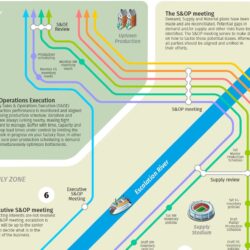Leadership crucial in Integrated Business Planning

A growing number of companies that have implemented Sales & Operations Planning (S&OP) are now taking the next step towards Integrated Business Planning (IBP). This means that the likes of the Finance and Strategy departments are joining their Sales, Marketing and Production colleagues at the meetings, and the discussion is now also about money rather than just volumes. Experience has shown that this step can be harder than many people think. “It’s impossible to achieve the most advanced stage of IBP maturity without leadership.”
By Marieke Lenstra and Marcel te Lindert
Although many people use the terms Sales & Operations Planning (S&OP) and Integrated Business Planning (IBP) interchangeably, they are not the same. In practice, they have different horizons and above all different scopes. And if the implementation goes well, they each have different reporting methods and involve different departments within the organization.
The biggest difference of IBP is that the Finance and Strategy departments take part in the meetings. Whereas S&OP revolves around the issue of how to meet demand as successfully as possible and/or how to make optimum use of production capacity, IBP considers two more questions: which solution generates the most profit and which steps must be taken in order to realize the strategy? And which product groups achieve the biggest margins and – if capacity is limited – should be given priority? “By the way, that doesn’t necessarily mean that each company must achieve the highest level of IBP maturity. After all, S&OP or IBP is not an end in itself. It should support the company’s strategy and culture,” says Gerard de Bruijn, who up until recently was Global Leader of IBP at brewing company Bavaria.
De Bruijn is an expert in the area of IBP design, coaching and implementation, having gained substantial experience not only at Bavaria, but also at Jacobs Douwe Egberts, Heinz in Europe and Asia/Indonesia, BP Castrol, C&A Mode and Farm Frites. During ‘Advancing S&OP to IBP’, a conference held in Amsterdam on 12 February 2018, De Bruijn ‘borrowed’ a model from Oliver Wight to illustrate and share his findings and observations. He was emphatic in his conclusion that almost none of the companies have unleashed the full potential of IBP: “It was much harder than I expected.”
Indispensable
His presentation revolved around the fact that good executive leadership is indispensable, by which he was clearly referring to the board of directors or executive board. “You can never achieve the most advanced stage of Integrated Business Planning maturity without good leadership. Otherwise, you not only get stuck at the basic level of S&OP, but it also results in good people leaving the company, good market opportunities remaining untapped and lots of unnecessary supply chain costs,” stated De Bruijn.
All the companies had different reasons for implementing IBP, different cultures and different strategies, and no two implementation projects were alike. The level of maturity they had reached after a couple of years differed too, with the most important factor being the management’s executive leadership. “If the management team don’t understand what IBP is and how it can add value and give the company more control, then you have to help them understand. They have to realize what they don’t yet know. Strategic decisions, such as about materials purchasing, are being made today based on an uncertain future. Or in the case of fashion companies, they have to decide which collections they will need a couple of seasons from now in order to reflect the trends at that time.” … … …
Want to read more?
Subscribe on iPad or Android tablet to read the full version >>
or
Subscribe on print to receive the next issue >>
This article was first published in Supply Chain Movement 29 | Q2 – 2018










